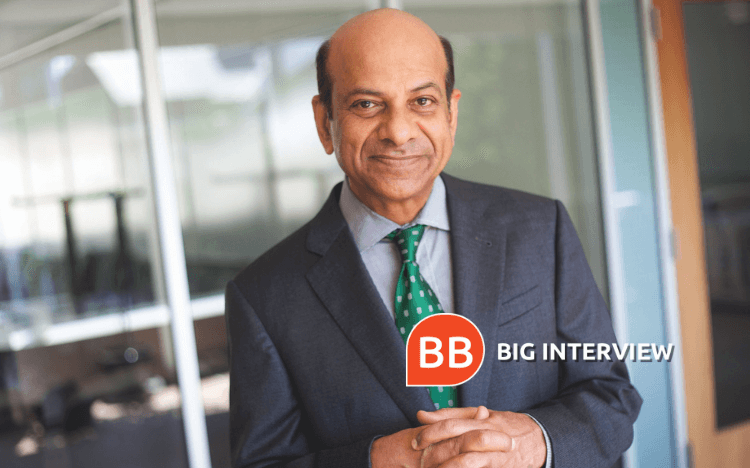Ever heard of Reverse Innovation? Harvard Business Review (HBR) recently named a 2009 paper on Reverse Innovation one of the 100 most influential and innovative articles the journal has ever published.
It was co-written by Dartmouth College Tuck School of Business professor Vijay Govindarajan.
Professor Govindarajan, or VG as he’s widely known, is one of the world’s most cited business and management scientists. He’s included in the Thinkers50 Hall of Fame, and in 2016 he authored a New York Times bestseller, The Three Box Solution.
In many ways, it was the concept of Reverse Innovation that VG introduced in 2009 that put him on the map. The Economist named him a rising star shortly after the article was published, and HBR later voted Reverse Innovation as one of the 10 big ideas of the decade.
What is Reverse Innovation?
At its core, Reverse innovation is about creating new innovations for an emerging market in order to both serve that market and create something you can later sell in rich countries.
“Historically, companies innovated in a rich country like the US and sold those products in a poorer country like India,” VG explains. “Reverse innovation is about doing exactly the opposite.”
Reverse Innovation is beneficial for several reasons. Emerging markets contain huge numbers of potential customers who have the same needs as rich consumers that often aren’t being serviced. Tapping into them opens new avenues for growth.
Reverse innovators also benefit from cheaper resources and labour. With less money flowing through them, emerging markets have a greater incentive to innovate cheaply, without sacrificing quality. VG contends that companies who reverse innovate can produce products which perform better than anything else on the market, at a lower price.
A range of household names including the likes of Microsoft and PepsiCo have harnessed the immense innovative power of emerging markets to create new products.

The example that birthed the concept came in 2009, when VG helped General Electric create the world’s first portable electrocardiogram (ECG) to service the needs of people in India.
“We opened up a whole new market in India with the ultra-low cost ECG machine, and then guess what? They were able to bring it to the US,” VG says.
By May 2010, GE had sold 7,500 of these portable ECG’s, with India—the target market—only accounting for 2,000 of those sales.
Reverse Innovation has developed in emerging tech-hubs
Since 2009, Reverse Innovation has transformed into a recognizable business strategy, utilized across a range of industries, from retail giant Levi Strauss to technology conglomerate Siemens.
Its influence has extended beyond multinational corporations. Reverse Innovation has helped grow many tech startups in emerging markets who have then moved into richer countries.
This includes Capillary Technologies, a cloud-based customer relationship management platform founded in India in 2008. The company’s founders spent three years developing their services domestically before looking for opportunities abroad, where they found large demand for their solutions.
Able to offer their services at a lower cost than competitors in richer countries, Capillary disrupted the market, offering better service at a discount price. It now operates in more than 30 countries with over 400 employees, and boasts Fortune 500 companies as clients.

Capillary is one of many tech companies to reap the rewards of Reverse Innovation in recent years. “We’ve seen a lot more excitement around Reverse Innovation, particularly given digital technologies,” VG explains. “What has happened in the last 10 years in India is exciting.”
Emerging tech hubs like Sao Paulo in Brazil, or Bangalore in the past, are well suited to Reverse Innovation because of the business models that tend to flourish there.
High tech startups in emerging markets often offer ultra-low-cost solutions to the widest possible consumer base. VG likens this to producing a sachet of shampoo for 100 customers, rather than supplying a whole bottle to one.
“Each person [in emerging markets] consumes small amounts but there are so many people that total consumption is high, whereas in the US we have fewer people but each one consumes a lot,” he explains.
This model helped food delivery app and restaurant aggregator, Zomato, expand from India into 24 countries and soar to a $12 billion valuation over the space of 13 years. The company has since scaled back its international business during the pandemic.
The nature of consumption in emerging markets provides a breeding ground for innovative high-tech startups, offering digital solutions that can be transferred to the rest of the world.
“That’s why I believe Reverse Innovation will benefit a lot from digital technologies, which are maturing so fast,” says VG.
Why Reverse Innovation is vital for pandemic recovery
While Reverse Innovation can create new business opportunities with innovative new products and services, the primary benefit VG identifies is its power to tackle inequality.
“The whole idea of Reverse Innovation is that if you innovate only for the rich, the poor can’t consume, but if you innovate for the poor, everyone can consume,” he explains.
This has never been more important than during the pandemic. The International Monetary Fund says Coronavirus forced more than 120 million people into extreme poverty, a situation likely to worsen with a global recession looming on the horizon. At the same time, the 400 richest people in America increased their wealth by 40%.

The gap between rich and poor is now a chasm that requires new ideas to tackle, VG says. “Once we accept all of us are human beings, then we need to have empathy for those unable to consume. Because they can’t pay the same prices, we need breakthrough innovation so we can bring down the cost.”
Despite the pandemic worsening the situation, VG feels it created conditions that are favorable to Reverse Innovation. “The pandemic has created an even bigger mass market in countries like India because people have just fallen down from one tier to the next,” he says.
It also rapidly increased adoption of digital technologies across industries like healthcare and education, and gave time to local entrepreneurs and multinational companies to come up with new innovative ideas.
All of these forces could combine to make Reverse Innovation more influential than ever before.
“These are problems which are going to be with us for a long, long time,” VG says. ”Innovation as a theme is going to be very important.”
For more insights follow the Weekly Column on innovation by Vijay Govindarajan on LinkedIn. You can also read more about the Three Box Solution, a strategy for leading innovation by Vijay Govindarajan.
Read more BusinessBecause Big Interviews
RECAPTHA :
6c
aa
98
61







